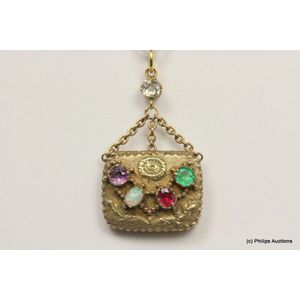Georgian Gemstone Purse Locket Pendant
You must be a subscriber, and be logged in to view price and dealer details.
Subscribe Now to view actual auction price for this item
When you subscribe, you have the option of setting the currency in which to display prices to $Au, $US, $NZ or Stg.
- Emeralds - Emeralds have been used in jewellery making for thousands of years, and are prized for their deep green colour, which is caused by the presence of chromium and vanadium in the mineral beryl. Because of their rare colour, emeralds are often more valuable than diamonds of a similar size and quality. In jewellery making, emeralds are typically cut into round or oval shapes to maximize their color and clarity. They are often set in gold or platinum and used as the centrepiece of a piece of jewellery, such as a ring or necklace. They can also be used in combination with other gems, such as diamonds, to create intricate and beautiful designs.
- Georgian - As an English stylistic period, Georgian is usually taken to cover the period from George I (1714) to the Regency of Prince George (1811-20), although the period from 1800 to 1830 is sometimes designated as the Regency period. During the Georgian period the great English cabinetmakers and designers such as Chippendale, Hepplewhite, Adam Sheraton etc., were all active.
Therefore there isn't a single 'Georgian style' as such and to say something is 'Georgian', usually means it was made between 1714 and 1830. This assumes we discount George V and George VI, both being from the 20th century.
The styles popular at the time of each reign were:
George I (1714-1727) saw out the last years of the Baroque period.
George II (1727-1760) reigned during the Rococo period.
George III (1760-1820) saw the last gasp of the Rococo, all of the early Neo-Classic 'Adam style' and most of the later neo-Classic 'Regency style'.
George IV (Prince Regent 1820-1830)encompassed the last of the 'Regency' style.
William IV's reign (1830-1837) was something of a no man's land (stylistically) and he wasn't a 'George' anyway. He covered the last glimmerings of 'Regency' and the start of the 'Victorian' style.
This item has been included into following indexes:
-
lockets
- diamond 3,475
- diamond and amethyst 2
- diamond and emeralds 6
- diamond and ruby 13
- photo and picture 130
- pendants and lockets, design - mourning and photographic 210
-
pendants and lockets, diamond
- diamond and amethyst 127
- diamond and emeralds 248
- diamond and ruby 229
- pendants and lockets, gold - gold with diamonds 3,395
- pendants and lockets, set with - opal 691
- pendants and lockets, type - photo 266
Visually similar items

An Australian 15ct yellow gold opal, aquamarine, pearl necklace one cushion shaped solid white opal, with some damage, seven round aquamarines, twenty two seed pearls. The pendant is attached to a belcher link chain made by T. Willis & Co., Melbourne. As s

A Victorian 15ct gold locket pendant & chain; front set with turquoise and a garnet to rear locket compartment on a rope chain. Length 42 cm. Wt. 20.3g

Pair of sterling silver decanter labels for Gin and Whisky

An Edwardian pendant and two chains, the pendant crafted in 15ct yellow gold, Edwardian, designed as an ornately scrolled panel of leaf and tendril inspired rails, each grain set with seed pearls, centrally detailed by a pink paste stone, dropping to a fur
